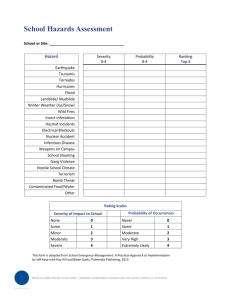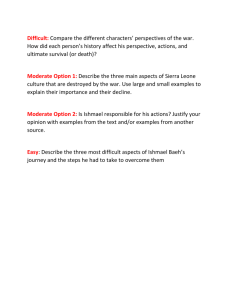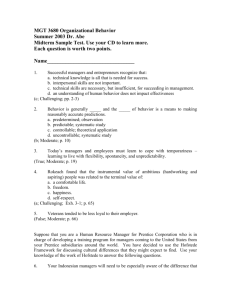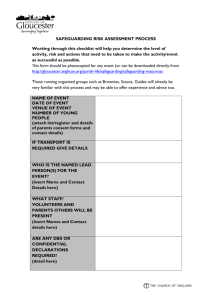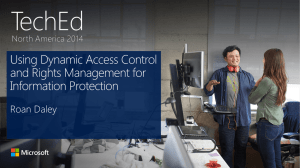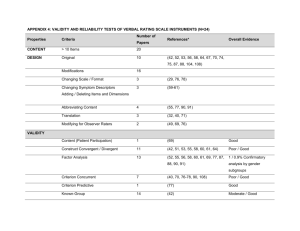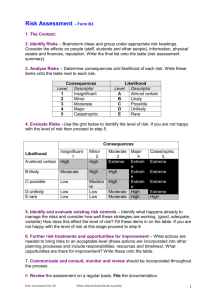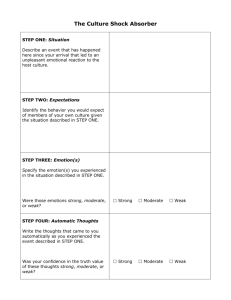Solution:Practice Questions 7
advertisement
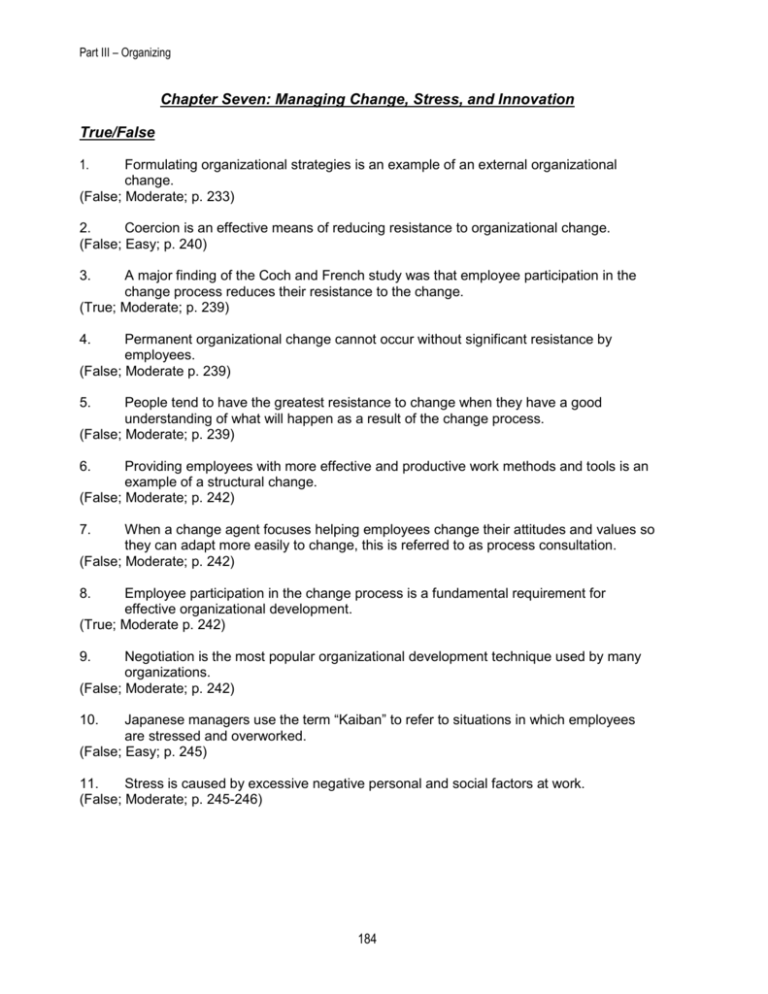
Part III – Organizing Chapter Seven: Managing Change, Stress, and Innovation True/False 1. Formulating organizational strategies is an example of an external organizational change. (False; Moderate; p. 233) 2. Coercion is an effective means of reducing resistance to organizational change. (False; Easy; p. 240) 3. A major finding of the Coch and French study was that employee participation in the change process reduces their resistance to the change. (True; Moderate; p. 239) 4. Permanent organizational change cannot occur without significant resistance by employees. (False; Moderate p. 239) 5. People tend to have the greatest resistance to change when they have a good understanding of what will happen as a result of the change process. (False; Moderate; p. 239) 6. Providing employees with more effective and productive work methods and tools is an example of a structural change. (False; Moderate; p. 242) 7. When a change agent focuses helping employees change their attitudes and values so they can adapt more easily to change, this is referred to as process consultation. (False; Moderate; p. 242) 8. Employee participation in the change process is a fundamental requirement for effective organizational development. (True; Moderate p. 242) 9. Negotiation is the most popular organizational development technique used by many organizations. (False; Moderate; p. 242) Japanese managers use the term “Kaiban” to refer to situations in which employees are stressed and overworked. (False; Easy; p. 245) 10. 11. Stress is caused by excessive negative personal and social factors at work. (False; Moderate; p. 245-246) 184 Chapter 7 – Managing Change, Stress, and Innovation 12. Role overload is often the result of having one person on a team at work perform too many functions or “wear too many hats.” (True; Easy; p. 246) 13. Role ambiguity can occur when an employee has poorly defined goals and objectives for his/her job. (True; Easy; p. 246) 14. People who exhibit a Type B personality usually put a great deal of pressure on themselves to perform, find it difficult to relax and are excessively competitive. (False; Easy p. 246) 15. Smoking, over-eating and insomnia are symptoms of physiological stress. (False; Moderate; p. 247) 16. Boredom, anxiety, withdrawal, conflict and tension are symptoms that managers should recognize as signs of psychological stress. (True; Moderate; p. 247) 17. A stress reduction program is any type of intervention designed to help employees remain healthy and fit by controlling their weight, smoking cessation and physical exercise. (False, Challenging; p. 248) 18. The process of taking an idea and turning it into a useful product is referred to as creativity. (False; Easy; p. 249) 19. Inspiration is an early step in the innovation process when prior efforts successfully come together. (False; Challenging; p. 250) 20. Innovative organizations demand collaboration among employees and therefore have little tolerance for conflict or disagreement between people. (False; Moderate; p. 250) 21. Technology and competition are examples of internal forces that dictate a need for change. (False; Moderate; p. 234) 22. A new or modified strategy is an internal source of change for an organization. (True; Moderate; p. 234) 23. Economic changes are external changes that affect almost all organizations. During these changes, some businesses are harmed while others prosper. (True; Moderate; p. 233) 24. People, both managers and nonmanagers, who act as catalysts and assume the responsibility for managing the change process are called catalyst agents. (False; Easy; p. 234) 185 Part III – Organizing 25. The "calm waters" metaphor envisions a trip over unfamiliar waters with a crew that has never before worked together. (False; Moderate; p. 234) 26. The prevailing model for handling change in "white waters" is best illustrated in Kurt Lewin's three-step description of the change process. (False; Challenging; pp. 234-235) 27. Since change is rarely a threat to managers and nonmanagerial personnel, managers should be motivated to initiate change because they are concerned with improving their organizations’ effectiveness. (False; Moderate; p. 237) 28. Coch and French concluded that employees must be involved for permanent change to occur without extensive resistance. (True; Moderate; p. 239) 29. Senior employees resist change more than new employees do. (True; Moderate; p. 239) 30. Joannie Calvert sees resistance to change at work as dysfunctional. She can choose from a list of common techniques to reduce this resistance. Joannie might use education and communication, participation, facilitation and support, negotiation, manipulation and cooptation, and coercion. (True; Challenging; pp. 239-240) 31. The effort to assist organizational members with a planned change is referred to as organizational design. (False; Moderate; p. 242) 32. Survey feedback efforts are designed to assess employee attitudes about and perceptions of the change they are encountering. (True; Moderate; p. 242) 33. Intergroup development is an activity that helps work groups set goals, develop positive interpersonal relationships, and clarify the roles and responsibilities of each team member. (False; Challenging; p. 243) 34. Regardless of the situation, removing the uncertainty or the importance of the work at hand will not remove the stress. (False; Moderate; p. 244) 35. In Japan, the concept of karoshi means death from overworking. (True; Moderate; p. 245) 36. Autonomy tends to lessen stress. (True; Moderate; p. 246) 186 Chapter 7 – Managing Change, Stress, and Innovation 37. Role conflict is created when role expectations are not clearly understood and the employee is not sure what he should do. (False; Challenging; p. 246) 38. Creativity is the ability to combine ideas in a unique way or to make unusual connections between things. (True; Moderate; p. 249) 39. The innovative organization is characterized by its ability to channel its creative abilities into useful outcomes. (True; Moderate; p. 249) 40. Some people believe that with training anyone can be creative. They view creativity as a fourfold process of perception, inspiration, innovation, and hard work. (False; Moderate; p. 249) 41. Frequent interunit communication helps to facilitate innovation. (True; Moderate; p. 250) 42. The incubation period in the process of innovation may take years to complete. (True; Moderate; p. 250) 43. An organizational culture that fosters innovation accepts ambiguity and has a low tolerance for risk. (False; Challenging; p. 250) 44. New idea champions are extremely self-confident, persistent, energetic, and have a tendency to take risks. (True; Moderate; p. 251) Multiple Choice Questions 45. In order to bring about effective organizational change, changes in technology need to be accompanied by making changes in _____. a. strategies b. structure c. people d. Both b and c (d; Moderate p. 232; Ex. 7-1) According to Kurt Lewin’s Model, ___________ involves instituting new systems and procedures to support the change process is referred to as: a. unfreezing b. freezing c. refreezing d. solidifying (c; Moderate; p. 235) 46. 187 Part III – Organizing 47. Overeating is a _____________ symptom of stress. a. physical b. behavioral c. psychological d. biological (b; Moderate; p. 247) 48. Harry is very competitive with his colleagues at work, hardly ever slows down or relaxes and strives constantly to exceed the highest sales targets in the company. Mary is productive but much more relaxed than Harry. She works hard but finds time for her personal life. Harry and Marry can be described as a. having a role conflict. b. having role overload. c. having excessive job stress. d. having different personality types (A and B). (d; Moderate; p. 246) 49. Jose is a manager in the finance department. He has just been given his objectives by his boss and is not sure whether he or his boss is responsible for completing the monthly budget forecast; this is an example of ________. a. role conflict b. role overload c. role ambiguity d. role inconsistency (c; Moderate; p. 246) 50. A focus group was used to help employees at GM evaluate the impact changes that related to employee attitudes, and work methods and productivity measures. These are examples of ___________________ change(s). a. technical b. technical and people c. structural d. structural and people (b; Moderate; p. 232; Ex. 71) 51. If a manager gets employees to adopt a new information system by telling them only about the benefits of the new system and omitting discussion of its limitations or deficiencies so that it will appear more attractive to them, he is __________ them. a. negotiating with b. coercing c. co-opting d. manipulating (d; Moderate; p. 240) 52. The union at the Saturn Plant was offered an 8% bonus to reduce their resistance to changes in work rules and scheduling. This is an example of ________ change. a. facilitating b. co-opting c. negotiating d. manipulating (c; Moderate; p. 240) 188 Chapter 7 – Managing Change, Stress, and Innovation 53. ________ conducted research that showed that resistance to permanent change could be eliminated by involving employees to actively participate in the change process. a. Kurt Lewin b. Coch and French c. Kaiban d. Hertzberg (b; Moderate; p. 239) 54. EAP programs a. are used exclusively to treat job-related stress. b. focus primarily on promoting health and wellness. c. provide employees with help finding jobs. d. help employees who are seeking an initial consultation for psychiatric problems or substance abuse. (d; Moderate; p. 248) 55. __________ is the process of creating new ideas and putting them into practice. a. Creativity b. Invention c. Entrepreneurship d. Innovation (d; Moderate; p. 249) 56. Which of the following is NOT one of the four steps in the product innovation process? a. Initial experimentation. b. Final application. c. Feasibility planning. d. Idea generation. (c; Easy; p. 249) 57. A(n) __________ is a person or group who takes leadership responsibility for managing in an organization or social system. a. change agent b. behavioral agent c. incubator d. innovator (a; Easy; p. 234) 58. __________ is the change phase described by Kurt Lewin in which a situation is prepared for change and felt needs for change are developed. a. Unfreezing b. Sensing c. Changing d. Refreezing (a; Moderate; p. 235) 189 Part III – Organizing 59. __________ is the phase described by Lewin in which something new takes place in the system, and change is actually implemented. a. Unfreezing b. Changing c. Transforming d. Refreezing (b; Moderate; p. 235; Ex. 72) 60. Changing, the second phase of Lewin's change model, can be accomplished by a. identifying new, more effective ways of behaving. b. choosing appropriate changes in tasks, people, culture, technology, and/or structure. c. taking action to put changes in tasks, people, culture, technology, and/or structure into place. d. All of the above. (d; Moderate; p. 235) 61. Stabilizing the change and creating the conditions for its long-term continuity occurs during the ____________ phase in Lewin’s Model. a. Unfreezing b. Refreezing c. Transforming d. Changing (b; Moderate; p. 235) 62. Which of the following does NOT accurately describe Lewin's model of organizational change? a. The change process consists of three phases. b. The change agent performs the same tasks during each phase of the change process. c. Modifying the organizational targets of tasks, people, culture, technology, and structure occurs during the changing phase of the process. d. Unfreezing involves preparing a system for change. (b; Challenging; pp. 235-236) 63. If change agent takes direct and unilateral action and order that change occurs, he or she using _____________ to make the change happen. a. manipulation b. coercion c. authority d. cooptation (b; Moderate; p. 2240) 64. Which of the following is NOT a reason why people resist change? a. Uncertainty b. Concern about Personal Loss. c. Fear of the unknown or future state d. Selfishness. (d; Easy; p. 238; Ex. 7-3) 190 Chapter 7 – Managing Change, Stress, and Innovation 65. All of the following are reasons why people resist change except a. Not understanding what is happening or what comes next. b. Not seeing how the change will benefit the organization. c. Self-centered, narrow-minded thinking. d. Not seeing any reason for the change. (c; Challenging; p. 238; Ex. 7-3) 66. A manager uses education and communication in order to overcome employee resistance to change. This means that the manager will a. allow employees to help design and implement the desired change. b. make use of discussions, presentations, or demonstrations to groups of employees in order to inform people about the proposed change. c. offer incentives, tradeoffs, or provide special benefits to accept the change. d. require employees to give their opinions about the change process. (b; Easy; p. 240) 67. A manager who uses participation and involvement in order to overcome employee resistance to change will __________. a. use discussion, presentations, and demonstrations to educate people beforehand about the change. b. try to covertly influence others by providing information selectively in favor of the desired change. c. provide encouragement and training beforehand about the change. d. allow others to contribute ideas and help design and implement the change. (d; Easy; p. 240) 68. Threatening and/or reminding employees of undesirable consequences if they resist a proposed change is the __________ approach to overcoming resistance to change. a. manipulation and cooptation b. coercion c. education and communication d. participation and involvement (b; Easy; p. 240) 69. __________ is an organizational development technique of collecting data, using it for planning, and evaluating the results. a. Process Consultation b. Team Building c. Survey Feedback d. Organizational design (c; Moderate; p. 242) If it weren’t for change, a manager’s job would be _____. a. boring b. useless c. easier d. not justified (c; Easy; p. 232) 70. 191 Part III – Organizing 71. A manager has basically three options when handling change. They include all of the following except a. altering structures. b. altering technology. c. altering competition. d. altering people. (c; Moderate; p. 232) 72. Managers can change an organization's structure. Which of the following is not a change in structure? a. work methods b. authority relationships c. job redesign d. spans of control (a; Moderate; p. 232; Ex. 71) 73. Managers have three options for change: structure, technology, and people. Which of the following is not a change in people? a. attitudes b. expectations c. spans of control d. behavior (c; Moderate; p. 232; Ex. 71) 74. Which of the following is not an external source of change for an organization? a. new competition b. redefined or modified strategy c. government laws and regulations d. technology (b; Moderate; p. 233) 75. Which of the following is not an internal source of change? a. redefined or modified strategy b. government laws and regulations c. employee attitudes d. management policies (b; Moderate; p. 234) 76. Susan has just attended a conference on new office technology that will dramatically impact the jobs of all administrative assistants. Workloads should be drastically reduced, but extensive training will be required. Susan is enthusiastic about the new technology and assumes the responsibility for the implementation of the equipment and the resulting training. Susan is which of the following? a. innovation agent b. creativity agent c. change agent d. technology agent (c; Easy; p. 234) 192 Chapter 7 – Managing Change, Stress, and Innovation 77. The metaphor that likens an organization to a sea captain and crew who know exactly where they are going because they have been there many times before is a. the "calm water" metaphor. b. the "white water rapids" metaphor. c. a dynamic environment. d. the parable of the boiled frog. (a; Easy; p. 234) 78. According to Kurt Lewin, change can be accomplished in all except which of the following ways? a. Driving forces can be increased. b. Status quo can be reinforced. c. Restraining forces can be decreased. d. Driving forces and restraining forces can be combined. (b; Challenging; p. 235) 79. In Lewin's three-step process, the objective of refreezing is a. to direct behavior away from the status quo. b. to hinder movement from the existing equilibrium. c. to implement change. d. to stabilize the new situation. (d; Challenging; p. 235) 80. Roger Kaputnick is a newly hired manager for Extreme Sports LTD. He is finding that a manager’s environments are both dynamic and _____. a. impossible b. certain c. uncertain d. predictable (c; Moderate; p. 235) 81. Most competitive advantages last less than _____ months. a. three b. six c. twelve d. eighteen (d; Challenging; p. 237) 82. The entrepreneur must act as a coach and a cheerleader in explaining change to employees. Which of these would he or she be likely to do? a. Motivate employees to put forth their best effort. b. Get employees excited about the change. c. Support and explain the change and the change efforts. d. All of the above. (d; Moderate; p. 237) 193 Part III – Organizing 83. Changes substitute _____ for the known. a. ambiguity and uncertainty b. certainty c. status quo d. rational decision making (a; Easy; p. 238) The Coch and French study still holds a major key for today’s organizational change; that is, for permanent change to occur without extensive resistance, _____. a. changes must occur slowly b. employees must be involved c. MBO is the best method to make the transition smooth d. employees must be rewarded for making the change efforts (b; Challenging; p. 239) 84. 85. For permanent change to occur without extensive resistance, based on the Coch and French study, what must happen? a. top management involvement b. stockholder involvement c. employee participation d. stakeholder participation (c; Moderate; p. 239) 86. Which of the following is not a reason people resist change? a. uncertainty b. concern over personal loss c. concern over personal gain d. the belief that the change is not in the organization's best interest (c; Moderate; p. 237) 87. All but which of the following are techniques that managers can use to reduce resistance to change? a. coercion b. facilitation and support c. top management dictates the change d. cooptation (c; Moderate; p. 240; Ex. 74) 88. Which technique for reducing resistance to change may not work when mutual trust and credibility are lacking? a. participation b. education and communication c. coercion d. negotiation (b; Challenging; p. 240; Ex. 74) 194 Chapter 7 – Managing Change, Stress, and Innovation 89. Which of the following can be used to reduce resistance to change when the resistance is due to misinformation? a. coercion b. facilitation and support c. negotiation d. education and communication (d; Moderate; p. 240; Ex. 74) 90. Fred's Furniture Store has been losing money, and Fred has decided to reduce his sales staff. In describing the upcoming changes, Fred distorts the facts in an effort to make the situation seem less threatening to the employees. Fred is guilty of a. manipulation and cooptation. b. coercion. c. negotiation. d. cooperation. (a; Moderate; p. 240) 91. Bob has told his employees that if they will agree to transfer to the Seattle office, they will all receive a 25% increase in salary. Bob is using a. manipulation and cooptation. b. coercion. c. negotiation. d. cooperation. (c; Moderate; p. 240) 92. Changes in authority relationships, coordination mechanisms, job design, or degree of centralization fall under which category of options that a manager can change? a. structure b. technology c. people d. management (a; Moderate; p. 240) 93. Changes in the way work is processed or the methods and equipment used fall under which category of options that a manager can change? a. structure b. technology c. people d. management (b; Easy; p. 241) 94. Changes in employee attitudes, expectations, perceptions, or behaviors fall under which category of options that a manager can change? a. structure b. technology c. people d. management (c; Moderate; p. 242) 195 Part III – Organizing 95. Rosebow Inc. has instituted a performance-based pay system that has motivated employees to work harder. This is an example of a change in a. people. b. technology. c. culture. d. structure. (a; Moderate; p. 242) 96. The focus of _____ is to constructively change the attitudes and values of organizational members so they can more readily adapt to, and be more effective in achieving the new directions of the organization. a. organization culture b. strategic human resource planning c. organizational development d. process consultation (c; Moderate; p. 242) 97. One of the fundamental issues behind organizational development is its reliance on _____ in an effort to foster an environment in which open communication and trust exists. a. top management participation b. middle management participation c. supervisory participation d. employee participation (d; Challenging; p. 242) 98. Which of the following is not one of the more popular organization development efforts used in organizations? a. survey feedback b. process consultation c. team building d. employee assistance programs (d; Moderate; p. 242) 99. _____ is/are the organization development technique(s) where efforts are designed to assess employee attitudes and perceptions of the change by responding to a specific set of questions. a. Survey feedback b. Process consultation c. Team building d. Employee assistance programs (a; Moderate; p. 242) 100. When an outside consultant helps managers perceive, understand, and act upon process events with which they must deal, the organization is using which organization development technique? a. survey feedback b. process consultation c. team building d. employee assistance programs (b; Easy; p. 242) 196 Chapter 7 – Managing Change, Stress, and Innovation 101. In _____, outside consultants act as coaches to help managers diagnose the interpersonal processes that need improvement. a. survey feedback b. team building c. process consultation d. intergroup development (c; Challenging; p. 242) 102. _____ is generally an activity that helps work groups set goals, develop positive interpersonal relationships, and clarify the role and responsibilities of each team member. a. Process consultation b. Survey feedback c. Intergroup development d. Team building (d; Moderate; p. 243) 103. Helping different work groups to become more cohesive involves using which organization development technique? a. survey feedback b. process consultation c. team building d. intergroup development (d; Moderate; p. 243) 104. Stress is said to be ____________ when the situation offers someone an opportunity to gain something. a. negative b. positive c. irrelevant d. overwhelming (b; Moderate; p. 244) 105. _____ are barriers that keep us from doing what we desire. a. Constraints b. Restraints c. Demands d. Stressors (a; Moderate; p. 244) 106. Constraints and demands can lead to potential _____. a. stress b. failure c. conflict d. dismissal (a; Moderate; p. 245) 197 Part III – Organizing 107. It is important to note that both _____ personal factors may cause stress on the job. a. good and long-term b. negative and excessive c. good and bad d. expensive and negative (c; Easy; p. 244) 108. In Japan, which of the following is the term used to refer to death caused by overworking? a. kaiban b. karoshi c. kazaam d. overworked (b; Moderate; p. 244) 109. Pressures placed on an employee as a function of the particular role he or she plays in the organization are a. role demands. b. role conflicts. c. role overload. d. role ambiguity. (a; Moderate; p. 246) 110. _____ is experienced when an employee is expected to do more than time permits. a. Role demand b. Role overload c. Role conflict d. Role ambiguity (b; Moderate; p. 246) 111. Which of the following is an example of an organizational stressor? a. personality type b. family matters c. financial problems d. restructuring (d; Moderate; p. 246; Ex. 76) 112. Which of the following is considered a personal stressor? a. role ambiguity b. financial problems c. reengineering d. role conflict (b; Challenging; p. 246; Ex. 76) 198 Chapter 7 – Managing Change, Stress, and Innovation 113. George constantly strives to excel. He must always get the highest grade in the class and has a sense of urgency about him at all times. George probably has which of the following? a. type A personality b. type B personality c. hyperactivity d. karoshi (a; Moderate; p. 246) 114. Kevin is a very relaxed, easy-going person who appears to have all the time in the world. He is never too busy to stop and chat for a moment. Kevin has which of the following? a. type A personality b. type B personality c. hyperactivity d. karoshi (b; Moderate; pp. 246-247) 115. All except which of the following are ways stress reveals itself? a. physiological b. psychological c. behavioral d. type B personality (d; Moderate; p. 247) 116. Whenever Jacob performs a musical solo, he experiences increased breathing and heart rates, and gets a headache. Jacob's stress is revealing itself in _____ symptoms. a. physiological b. psychological c. behaviorally related d. autonomic (a; Moderate; p. 247) 117. _____ symptoms of stress, such as anxiety, boredom, and procrastination can lead to productivity decreases. a. Physiological b. Psychological c. Behaviorally related d. Autonomic (b; Moderate; p. 247) 118. Since their early focus on alcoholic employees, _____ have ventured into new areas such as controlling rising health insurance premiums. a. wellness programs b. stress reduction programs c. employee assistance programs d. cafeteria style benefit programs (c; Challenging; p. 248) 199 Part III – Organizing 119. Campbell Soup Company offers a program for employees seeking the first step in psychiatric or substance-abuse help. They are offering a. employee assistance programs. b. wellness programs. c. stress reduction programs. d. human resource management. (a; Moderate; p. 248) 120. A local college offers its employees reduced rates when they use the physical fitness facilities, offers weight control seminars and nutrition education, and provides incentives for employees who stop smoking. The college has a. employee assistance programs. b. wellness programs. c. stress reduction programs. d. human resource management. (b; Moderate; p. 248) 121. Shonda Cretaleez has the ability to combine ideas at work in a unique way and often can make unusual associations between ideas. Her coworkers say Shonda possesses _____. a. genius b. superior observation powers c. brightness d. creativity (d; Moderate; p. 249) 122. _____ is the process of taking a new idea and turning it into a useful product. a. Creativity b. Innovation c. New products d. Entrepreneurship (b; Moderate; p. 249) 123. One view of creativity holds that with training, anyone can be creative. In this view, creativity is a fourfold process consisting of _____, incubation, inspiration, and _____. a. perception; innovation b. inclination; illustration c. ideas; procedure d. indoctrination; institutionalization (a; Moderate; pp. 249-250) 124. _____ involves how you see things. a. Innovation b. Perception c. Inspiration d. Attitude (b; Easy; p. 249) 200 Chapter 7 – Managing Change, Stress, and Innovation 125. Which of the following steps in the creativity process may take years before the idea finally "gels" and the next step occurs? a. perception b. incubation c. inspiration d. innovation (b; Moderate; p. 250) 126. The moment when all prior efforts in the innovative process successfully come together is known as a. perception. b. incubation. c. inspiration. d. innovation. (c; Moderate; p. 250) 127. Which of the following is not a variable that a manager can foster in order to stimulate innovation? a. structure variables b. culture variables c. human resource practices d. management practices (d; Moderate; p. 250) 128. An innovative culture is apt to have all except which of the following characteristics? a. low external controls b. tolerance of the impractical c. focus on means rather than ends d. tolerance for risk (c; Moderate; p. 250) 129. An innovative organization tends to do/have all of the following except _____. a. encourage experimentation b. reward both successes and failures c. celebrate mistakes d. low tolerance for conflict (d; Challenging; p. 250) Scenario-Based Questions Application of Resistance to Change Acme Feed Company is a small farmers' store located in eastern North Carolina. Because the surrounding farms have been taken over by corporate farmers, Acme's owners know that they must make some changes. The owners have decided to hire an "expert" to assist them in making the necessary changes. Acme currently employs fifteen people. Two individuals serve as managers and have been with Acme for over twenty years. Five employees have been hired in the last several years, and an additional eight employees are part-time workers who are attending the local agricultural college. 201 Part III – Organizing 130. The changes in the farms to which Acme sells are an example of a change in the _____ that affect the organization. a. internal environment b. technology c. economy d. people (c; Moderate; p. 233) 131. The outside consultant will serve as a _____ in helping Acme through the change process. a. change agent b. senior manager c. legal consultant d. calming influence (a; Easy; p. 234) 132. Which of the following is probably the primary reason the senior managers are resisting the change? a. uncertainty b. concern over personal loss c. concern over personal gain d. the belief that the change is not in the organization's best interest (b; Challenging; p. 237) 133. Which group is most likely to resist the changes? a. new employees b. senior employees c. new managers d. stockholders (b; Moderate; p. 238) 134. Which technique to reduce the resistance to changing the organizational structure may be a good first step? a. coercion b. facilitation and support c. participation d. education and communication (d; Challenging; p. 240) 135. Since the full-time employees have some expertise to make a contribution to the changes, management should consider _____ next, even though it is time-consuming and has potential for a poor solution. a. coercion b. participation c. negotiation d. cooptation (b; Moderate; p. 240; Ex. 74) 202 Chapter 7 – Managing Change, Stress, and Innovation Application of Organizational Change Krista is unsure what to do next. Her company is about to implement a radical new technology transformation that will affect every person in the organization. They are basically updating their plant to the 21st century, and almost everything is changing. Krista is in charge of assisting the members of the company with the planned changes. Since it is a long-term change that is organization-wide, management felt that someone needed to facilitate the change because, in essence, it was changing the culture of the company. The first thing Krista did was to ask employees a specific set of questions about the perceived changes. From this data, Krista then needed to decide what to do next. An outside consultant has been hired to help Krista diagnose the interpersonal processes that needed improvement. The move from functional departmentalization to work teams was a change necessitated by the new technology. This was a major change for employees who had worked in specific departments for most of their careers. Furthermore, the teams will have to interact with each other as they use the new technology. Krista feels that her task is almost overwhelming. 136. Krista is in charge of a. human resource management. b. strategic human resource planning. c. organizational development. d. cultural change. (c; Moderate; p. 242) 137. The first step that Krista took was a. survey feedback. b. process consultation. c. team building. d. intergroup development. (a; Moderate; p. 242) 138. The outside consultant was performing which of the following? a. survey feedback b. process consultation c. team building d. intergroup development (b; Moderate; p. 242) 139. Due to the fact that teams are a new component of this organization, which of the following may help develop positive interpersonal relationships and clarify the roles and responsibilities of each team member? a. survey feedback b. process consultation c. team building d. intergroup development (c; Easy; p. 243) 203 Part III – Organizing 140. Since the work groups will ultimately be required to work together fairly closely, which of the following may be necessary? a. survey feedback b. process consultation c. team building d. intergroup development (d; Moderate; p. 243) 141. The ultimate goal of intergroup development is _____. a. goal achievement b. better coordination c. efficiency d. to save money (b; Moderate; p. 243) Application of "What Is Stress?" Kevin is a very relaxed, easy-going employee. When the new technological processes were implemented last month, he was able to easily accept the changes and start working through learning the new techniques necessary to use the new processes. George, on the other hand, was concerned about the new technology long before it was ever implemented. He was afraid he would no longer be able to be the top performer in his department. He has had several problems adapting to the new situation. George works very long hours, 6070 hours each week. 142. George is overeating, drinking and smoking excessively due to the pressure at work. These are symptoms of ____________ stress. a. psychological b. organizational c. behavioral d. physiological (c; Moderate; p. 247) Mary is George’s supervisor. After several months of working 60-70 hour weeks, Mary notices that George is arriving late to work, having conflict with his co-worker, and is frequently absent. Realizing that this is a stress-related problem Mary suggests that a. George take a vacation. b. George seek help from the EAP. c. George enroll in a health and wellness program. d. George stop coming in late and missing work. (b; Moderate; p. 248) 143. 144. George and Kevin have both been assigned joint responsibility to manage the department budget. Since, these two managers have very different styles and do not like to work with one another, they are likely to experience stress resulting from _________________. a. role demands b. role conflict c. role overload d. interpersonal demands (d; Easy; p. 246) 204 Chapter 7 – Managing Change, Stress, and Innovation During the past six months, George’s employer Children’s Media and Books experienced declining sales combined with an increase in the costs of publication licensing. As a result the company had to eliminate over 600 jobs. Unfortunately, 5 people who worked with George left the company leaving George with responsibility for doing their jobs as well as his own. The stress that George experiences is most likely the result of a. role confusion. b. role overload. c. role ambiguity. d. type A personality. (b; Challenging; p. 246) 145. 146. George spends excessive time at work because he is not sure of his job roles and responsibilities and given his personality he wants to make sure to get the job done. His supervisor has not clearly defined what his responsibilities or made clear her expectations. Based on his situation, ___________ is (are) a major factor contributing to George’s stress at work. a. role demands b. role conflicts c. role ambiguity d. Kevin’s personality (c; Moderate; p. 246) 147. Under which of the following categories of stress does the new technology fall? a. personal stressors b. organizational stressors c. type A personalities d. type B personalities (b; Moderate; p. 246) 148. Kevin readily accepts the factors related to his job called _____. a. task demands b. role ambiguity c. hyperactive d. karoshi (a; Moderate; pp. 245-246) 149. Which of the following might describe George? a. type A personality b. type B personality c. type C personality d. karoshi (d; Easy; p. 246) 150. Which of the following symptoms are George's fellow employees and supervisors most apt to notice that may indicate that he is suffering from stress? a. high blood pressure b. changes in metabolism c. sleep problems d. increased tension and anxiety (d; Challenging; p. 246) 205 Part III – Organizing 151. Which type of employee is most likely to show signs of stress even if his organizational and personal stressors are low? a. type A personality b. type B personality c. hyperactivity d. karoshi (a; Moderate; p. 246) Short Discussion Questions 152. Describe the three ways that managers can facilitate the change process by helping employees overcome resistance to change. Education and communication can help reduce resistance to change by helping employees see the logic of the change effort. This technique assumes that much of the resistance lies in misinformation or poor communication. Participation involves bringing those individuals directly affected by the proposed change into the decision-making process. Participation allows these individuals to express their feelings, increase the quality of the process, and increase employee commitment to the final decision. Facilitation and support involve helping employees deal with the fear and anxiety associated with the change effort. This help may include employee counseling, therapy, new skills training, or a short paid leave of absence. (Easy; p. 240) 153. Describe the symptoms of psychological and behavioral stress The psychological symptoms can be seen as increased tension and anxiety, boredom, and procrastination—all of which can lead to productivity decreases. Behavior-related symptoms— changes in eating habits, increased smoking or substance consumption, rapid speech, or sleep disorders. (Easy; p. 247) 154. Identify external versus internal forces of change. External sources—competition, governmental laws and regulations, technology, and economic changes. Internal sources—redefinition or modification of strategy, new equipment, changing workforce, compensation packages, employee attitudes, and management policies. (Moderate; pp. 233234) 155. Explain the three primary reasons people are apt to resist change. Fear of personal loss. The uncertainty created. The belief that change is not in the organization's best interest. (Easy; p. 238; Ex. 73) 206 Chapter 7 – Managing Change, Stress, and Innovation 156. Differentiate between (a) negotiation, (b) manipulation and cooptation, and (c) coercion. Negotiation involves a bargain or an exchange of something of value. Manipulation and cooptation refer to covert attempts to influence others. Coercion involves the use of direct threats or force. (Easy; p. 240; Ex. 74) 157. Why would a company undertake organization development? Organization development facilitates long-term organization-wide changes. Its focus is to constructively change the attitudes and values of organizational members so that they can more readily adapt to and be more effective in achieving the new directions of the organization. (Challenging; pp. 242-243) 158. What are the symptoms of stress? Psychological symptoms include increased tension and anxiety, boredom, and procrastination. Physiological symptoms include changes in metabolism, increased heart and breathing rates, increased blood pressure, headaches, and increased risk of heart attacks. Behaviorally related symptoms include changes in eating habits, increased smoking or substance consumption, rapid speech, or sleep disorders. (Challenging; p. 247) 159. Distinguish between role conflicts, overload, and ambiguity. Role conflicts create expectations that may be hard to reconcile or satisfy. Role overload is experienced when the employee is expected to do more than time permits. Role ambiguity is created when role expectations are not clearly understood and that employee is not sure what he or she is to do. (Moderate; p. 246) 160. Differentiate between creativity and innovation. Creativity is the ability to look at things in a new and unique way. Innovation is the ability to take an idea and turn it into a useful product, service, or operation method. (Easy; p. 249) Medium-Length Essays 161. Compare and contrast the major differences between Type A and Type B personality. What differences might exist between the way people with these two styles interact with and impact their peers and/or subordinates at work? Type A personality is characterized by feelings of a chronic sense of time urgency, an excessive competitive drive, and difficulty accepting and enjoying leisure time. Only the hostility and anger associated with Type A behavior is actually associated with the negative effects of stress. Poor relationships with co-workers include driven and competitive behavior. Type B’s never suffer from time urgency or impatience. Type B’s are just as susceptible to the same anxiety-producing elements as Type A’s. Type B’s are often criticized by because their 207 Part III – Organizing relaxed nature may be mistaken for less commitment, lower motivation or being less productive compared to Type A’s. (Easy; pp. 246) 162. Compare and contrast the following two metaphors: "calm waters" versus "white water rapids." Calm waters—change is an unnatural break in the equilibrium that occurs infrequently while the organization sails through waters it knows to a certain destination with a crew who has worked together for years. White water rapids—change is constant, unpredictable, and uncertain so the small canoe is moving through waters that are constantly changing towards a destination that is unknown with a crew who is unfamiliar with each other. (Moderate; pp. 234-235) 163. How do entrepreneurs handle change? Entrepreneurs must be alert to problems and opportunities that may create the need for change. They must recognize the critical roles they play in stimulating and implementing change. They also need to explain the change and support its implementation. Finally, they must guide the actual change process. (Moderate; p. 237) 164. Define organization development, and explain four typical organization development techniques. Organization development—an activity designed to facilitate planned, long-term organizationwide change that focuses on the attitudes and values of organizational members; essentially an effort to change an organization's culture. Four typical organization development techniques are: Survey feedback—a method of assessing employees' attitudes about and perceptions of a change by asking specific questions. Process consultation—uses consultants as change agents. Team building—helps work groups set goals, develop relationships, and clarify roles and responsibilities. Intergroup development—attempts to make several work groups become more cohesive. (Challenging; pp. 242-243) 165. What is a stressor? Describe the two major categories of stressors, and give examples. Stressor—factor that causes stress. Organizational stressors include task demands, role demands, interpersonal demands, organization structure, and organization leadership. Personal stressors include personality type, family matters, and financial problems. (Moderate; p. 246; Ex. 76) Comprehensive Essays 166. How can a manager serve as a change agent? Describe the major organizational development techniques used to facilitate the change process. Changes within an organization need a catalyst. Managers who serve as catalysts and assume the responsibility for managing the change process are called change agents. No manager can also be a change agent. 208 Chapter 7 – Managing Change, Stress, and Innovation Here are some of the requirements and characteristics of effective change agents: Effective change agents need to have understanding of the organization’s history, culture, operating procedures, and personnel. Managers who act as change agents may be more thoughtful and possibly more cautious. The services of outside consultants can also be used to bring in fresh perspectives and solutions. Here are some common OD interventions and techniques used by change agents: 1. Education and communication help employees see the logic of the change effort. 2. Participation involves bringing those individuals directly affected by the proposed change into the decision-making process. 3. Facilitation and support involve helping employees deal with the fear and anxiety associated with the change effort. 4. Negotiation involves a bargain: exchanging something of value for an agreement to lessen the resistance to the change effort. 5. Manipulation and cooptation refers to covert attempts to influence others about the change. 6. Coercion involves the use of direct threats or force against the resisters. Some Typical OD Techniques 1. The more popular OD efforts rely heavily on group dynamics, problem solving, structured interaction and cooperation. 2. Survey feedback efforts are designed to assess employee attitudes about and perceptions of the change they are encountering. 3. In process consultation, outside consultants help managers to perceive, understand, and act upon process events with which they must deal. 4. Team building is generally an activity that helps work groups set goals, develop positive interpersonal relationships, and clarify the roles and responsibilities of each team member. 5. Intergroup development attempts to achieve the same results among different work groups. (Moderate; pp. 234, 242-243) 167. Describe the three categories of change. Structure changes include authority relationships, coordinating mechanisms, job redesign, and spans of control. Technology change entails work processes, work methods, and equipment. People changes involve attitudes, expectations, perceptions, and behavior. (Moderate; p. 232; Ex. 71) 168. Explain Lewin's three-step process to describe the change process. (See Exhibit 7-2 for a diagram of the process.) The three steps are unfreezing the status quo, changing to a new state, and refreezing the new change to make it permanent. Unfreezing can be achieved in one of three ways: driving forces can be increased, restraining forces can be decreased, or the two approaches can be combined. (Moderate; pp. 235-236) 209 Part III – Organizing 169. Describe how organizations can stimulate innovation. Structure should be flexible, have fewer rules, plentiful resources, and interunit communication. A culture that encourages experimentation, rewards for both success and failure, and promotes risk-taking should be used. Human resources that focus on employee training and development are the key. Product champions who are allowed decision-making discretion and autonomy produce results. (Challenging; p. 250) 210
